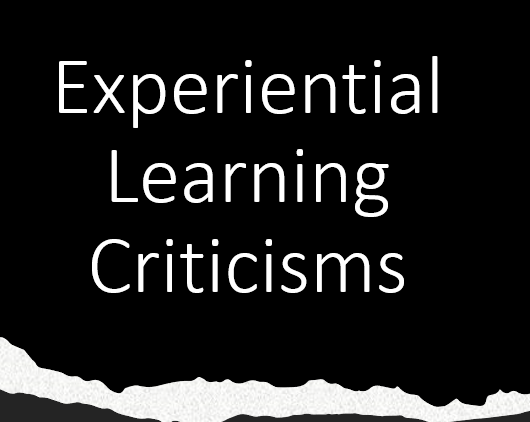For all of the positive aspects to experiential learning and those who support this method of learning, there are also noted criticisms or weaknesses to this approach. This is not a comprehensive list.
Experiential learning is not just a plug and play option. It can take time for the student, learner or individual to get used to the experiential process. This is not too difficult to understand or to believe. We tend to coast through life in a passive capacity. It will take a change of mind and heart to start investigating experiences. It takes effort. It takes desire. It takes dedication.
This is especially true for those who have been more accustomed to a teacher-centered learning approach. Ponder what it is like to move from an entirely lecture approach to a hands-on learning approach. The same idea applies for those who are used to a teacher-centered approach and attempting to start using experiential learning.
Another criticism is that practitioners will jump into using experiential learning without understanding the barriers such as attempting to do too much. Think of it like buying a new house and immediately starting a big project like moving plumbing before doing more simple projects. When introducing experiential learning to a new learner, start with a small project or small learning experience before tackling larger investigations.
Next, be sure to give enough time. Many educators attempt to introduce experiential learning but are determined to confine it to part of a class period. More open-ended time frames need to be made available for the practice and especially for the new experiential learner.
Solitary learning is often mistaken as a concept of experiential learning due to the reflective component. But this is not the case. Learners need to be encouraged to collaborate with others. When using experiential learning within a classroom setting, set aside time for quiet learning for the introverted, solitary learner and more interactive time for the extraverted, social learner. Encourage both types of learners to attempt learning in their less preferred method.
Do not introduce too much information or experiential guidelines at one time. This will exasperate and frustrate a new learner. Additionally, there is a careful balance between the active learning experience and the analyzing time and reflection. Be sure to give a substantial amount of time for both activities.
“Reluctant learners” is also a consideration when introducing any new learning/teaching methodology. Be sensitive to these individuals, remembering that everyone adapts to change at different rates. For more information on how people adapt to change, investigate and research change management.
For those learners who need guidelines, find ways to implement them. Look at how you can demonstrate timelines and checklists to aid them through this more free flowing type of learning. Be sure to explain that experiential learning is a personalized journey. Individuals can use a less structured approach or include a more structured approach like using reflective learning steps.
Many educators wrongly assume that experiential learning is completely without structure and requires little to no planning. This is wrong. It requires the same amount if not more planning than other more traditional methodologies. Some planning needs to take place but avoid over planning with timelines and restrictions. Experiential learning can be a bit unscripted, but this does not mean that planning should not take place. Simply be flexible. Your learners are also a valuable resource. Let them in on the planning.
When using experiential learning, be prepared to let go of your plans and move in a completely different direction. This part of experiential learning can be disconcerting to educators who are used to having objectives, concrete plans, timelines and rubrics. This lack of clarity in planning, however, does not impede the learning experience. It actually enhances learning as the learner will walk down unexpected venues that lead to unexpected insights, learning and growth.
Be sure to use reflective practice to debrief the experiential learning. Otherwise, the learning event becomes nothing more than just another learning activity. The point is to develop deeper learning which will occur only when there is a debriefing. There are many options for debriefing when using experiential learning.
Assessment is a criticism. There is a lack of formal, traditional assessment practices when using experiential learning. This can be frustrating to educators.
Be being aware of these criticisms and downfalls, an educator can approach experiential learning in a way that will avoid these problems.



Comments are closed